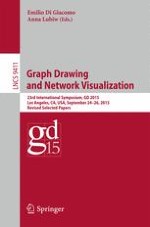This book constitutes the proceedings of the 23rd International Symposium on Graph Drawing and Network Visualization, GD 2015, held in Los Angeles, Ca, USA, in September 2015.
The 35 full papers presented together with 7 short papers and 8 posters in this volume were carefully reviewed and selected from 77 submissions. Graph Drawing is concerned with the geometric representation of graphs and constitutes the algorithmic core of Network Visualization. Graph Drawing and Network Visualization are motivated by applications where it is crucial to visually analyze and interact with relational datasets. Examples of such application areas include social sciences, Internet and Web computing, information systems, computational biology, networking, VLSI circuit design, and software engineering.
This year the Steering Committee of GD decided to extend the name of the conference from the "International Symposium on Graph Drawing" to the "International Symposium on Graph Drawing and Network Visualization" in order to better emphasize the dual focus of the conference on combinatorial and algorithmic aspects as well as the design of network visualization systems and interfaces.
